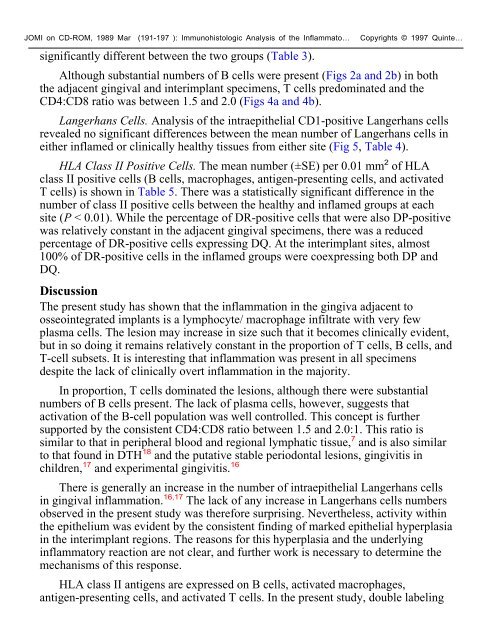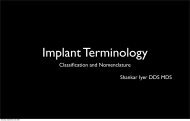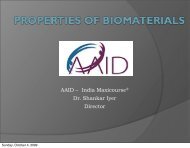Immunohistologic Analysis of the Inflammatory Infiltrates Associated ...
Immunohistologic Analysis of the Inflammatory Infiltrates Associated ...
Immunohistologic Analysis of the Inflammatory Infiltrates Associated ...
Create successful ePaper yourself
Turn your PDF publications into a flip-book with our unique Google optimized e-Paper software.
JOMI on CD-ROM, 1989 Mar (191-197 ): <strong>Immunohistologic</strong> <strong>Analysis</strong> <strong>of</strong> <strong>the</strong> Inflammato…<br />
Copyrights © 1997 Quinte…<br />
significantly different between <strong>the</strong> two groups (Table 3).<br />
Although substantial numbers <strong>of</strong> B cells were present (Figs 2a and 2b) in both<br />
<strong>the</strong> adjacent gingival and interimplant specimens, T cells predominated and <strong>the</strong><br />
CD4:CD8 ratio was between 1.5 and 2.0 (Figs 4a and 4b).<br />
Langerhans Cells. <strong>Analysis</strong> <strong>of</strong> <strong>the</strong> intraepi<strong>the</strong>lial CD1-positive Langerhans cells<br />
revealed no significant differences between <strong>the</strong> mean number <strong>of</strong> Langerhans cells in<br />
ei<strong>the</strong>r inflamed or clinically healthy tissues from ei<strong>the</strong>r site (Fig 5, Table 4).<br />
HLA Class II Positive Cells. The mean number (±SE) per 0.01 mm2 <strong>of</strong> HLA<br />
class II positive cells (B cells, macrophages, antigen-presenting cells, and activated<br />
T cells) is shown in Table 5. There was a statistically significant difference in <strong>the</strong><br />
number <strong>of</strong> class II positive cells between <strong>the</strong> healthy and inflamed groups at each<br />
site (P < 0.01). While <strong>the</strong> percentage <strong>of</strong> DR-positive cells that were also DP-positive<br />
was relatively constant in <strong>the</strong> adjacent gingival specimens, <strong>the</strong>re was a reduced<br />
percentage <strong>of</strong> DR-positive cells expressing DQ. At <strong>the</strong> interimplant sites, almost<br />
100% <strong>of</strong> DR-positive cells in <strong>the</strong> inflamed groups were coexpressing both DP and<br />
DQ.<br />
Discussion<br />
The present study has shown that <strong>the</strong> inflammation in <strong>the</strong> gingiva adjacent to<br />
osseointegrated implants is a lymphocyte/ macrophage infiltrate with very few<br />
plasma cells. The lesion may increase in size such that it becomes clinically evident,<br />
but in so doing it remains relatively constant in <strong>the</strong> proportion <strong>of</strong> T cells, B cells, and<br />
T-cell subsets. It is interesting that inflammation was present in all specimens<br />
despite <strong>the</strong> lack <strong>of</strong> clinically overt inflammation in <strong>the</strong> majority.<br />
In proportion, T cells dominated <strong>the</strong> lesions, although <strong>the</strong>re were substantial<br />
numbers <strong>of</strong> B cells present. The lack <strong>of</strong> plasma cells, however, suggests that<br />
activation <strong>of</strong> <strong>the</strong> B-cell population was well controlled. This concept is fur<strong>the</strong>r<br />
supported by <strong>the</strong> consistent CD4:CD8 ratio between 1.5 and 2.0:1. This ratio is<br />
similar to that in peripheral blood and regional lymphatic tissue,7 and is also similar<br />
to that found in DTH18 and <strong>the</strong> putative stable periodontal lesions, gingivitis in<br />
children,17 and experimental gingivitis.16<br />
There is generally an increase in <strong>the</strong> number <strong>of</strong> intraepi<strong>the</strong>lial Langerhans cells<br />
in gingival inflammation.16,17 The lack <strong>of</strong> any increase in Langerhans cells numbers<br />
observed in <strong>the</strong> present study was <strong>the</strong>refore surprising. Never<strong>the</strong>less, activity within<br />
<strong>the</strong> epi<strong>the</strong>lium was evident by <strong>the</strong> consistent finding <strong>of</strong> marked epi<strong>the</strong>lial hyperplasia<br />
in <strong>the</strong> interimplant regions. The reasons for this hyperplasia and <strong>the</strong> underlying<br />
inflammatory reaction are not clear, and fur<strong>the</strong>r work is necessary to determine <strong>the</strong><br />
mechanisms <strong>of</strong> this response.<br />
HLA class II antigens are expressed on B cells, activated macrophages,<br />
antigen-presenting cells, and activated T cells. In <strong>the</strong> present study, double labeling




